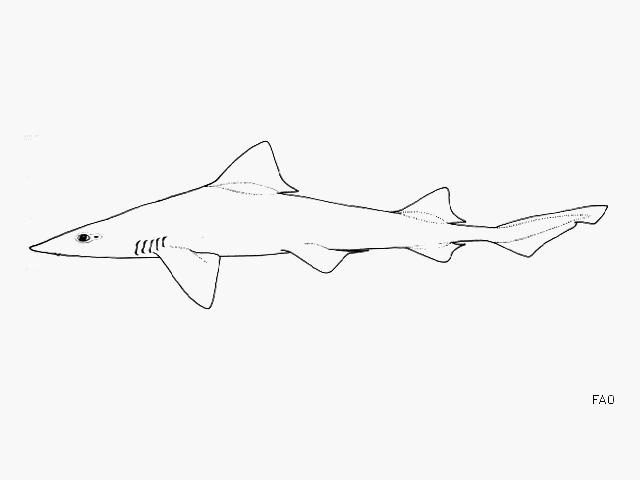Mustelus dorsalis
Gill, 1864
Sharptooth smooth-hound
Classification: Elasmobranchii Carcharhiniformes Triakidae
Reference of the original description
Second contribution to the Selachology of California. Proceedings of the Academy of Natural Sciences of Philadelphia, 16, 147–151
Second contribution to the Selachology of California. Proceedings of the Academy of Natural Sciences of Philadelphia, 16, 147–151
Image of the original description
No image in first description.
No image in first description.
Synonyms / new combinations and misspellings
Galeorhinus dorsalis, Galeus dorsalis, Mustelus cf. dorsalis
Galeorhinus dorsalis, Galeus dorsalis, Mustelus cf. dorsalis
Description :
Citation: Mustelus dorsalis Gill, 1864: In: Database of modern sharks, rays and chimaeras, www.shark-references.com, World Wide Web electronic publication, Version 12/2025
Please send your images of "Mustelus dorsalis" to info@shark-references.com

Mustelus dorsalis Gill, 1864, © FAO, www.fish-base.org

Mustelus dorsalis Gill, 1864, © FAO, www.fish-base.org
Common names
 Cazón blanco,
Cazón blanco,  Cazón de leche,
Cazón de leche,  Cazón tripa,
Cazón tripa,  Musola blanca,
Musola blanca,  Piruche,
Piruche,  Tollo,
Tollo,  Tollo blanco,
Tollo blanco,  Vieja,
Vieja,  Emissole blanche,
Emissole blanche,  Sharp-tooth smooth hound,
Sharp-tooth smooth hound,  Sharpnose smooth hound,
Sharpnose smooth hound,  Sharptooth smoot-hound,
Sharptooth smoot-hound,  Sharptooth smooth-hound,
Sharptooth smooth-hound,  Sharptooth smoothhound
Sharptooth smoothhound
 Cazón blanco,
Cazón blanco,  Cazón de leche,
Cazón de leche,  Cazón tripa,
Cazón tripa,  Musola blanca,
Musola blanca,  Piruche,
Piruche,  Tollo,
Tollo,  Tollo blanco,
Tollo blanco,  Vieja,
Vieja,  Emissole blanche,
Emissole blanche,  Sharp-tooth smooth hound,
Sharp-tooth smooth hound,  Sharpnose smooth hound,
Sharpnose smooth hound,  Sharptooth smoot-hound,
Sharptooth smoot-hound,  Sharptooth smooth-hound,
Sharptooth smooth-hound,  Sharptooth smoothhound
Sharptooth smoothhound
Short Description
Diagnosis after Compagno, 1984 [517]: Body fairly slender. Head moderately long, prepectoral length 19 to 23% of total length; snout long and acutely angular in lateral view, preoral snout 6 to 8.8% of total length, preorbital snout 7.1 to 9.7% of total length; internarial space moderate, 2.1 to 3% of total length; eyes small, eye length 2.6 to 3.5 times in preorbital snout (over 3 times in adults) and 1.8 to 2.9% of total length; interorbital space very broad, 5.1 to 6.2% of total length; mouth long, greater than eye length, 3 to 4% of total length; upper labial furrows slightly longer than lowers or about as long, uppers 1.3 to 2.2% of total length; teeth cuspidate and asymmetric, with cusp prominent and cusplets occasionally present at all sizes; buccopharyngeal denticles present on anterior thirds of mouth floor and palate, and on gill arches. Interdorsal space 16 to 21% of total length; trailing edges of dorsal fins denticulate, without bare ceratotrichia; first dorsal broadly triangular, with posteroventrally sloping posterior margin, its midbase closer to pelvic bases than to pectorals; pectoral fins moderately large, length of anterior margins 12 to 16% of total length, width of posterior margins 8 to 14% of total length; pelvic fins moderately large, anterior margin length 6.7 to 9.1% of total length; anal height 2.7 to 3.4% of total length; anal-caudal space greater than second dorsal space and 4.8 to 6.8% of total length; ventral caudal lobe not falcate and weakly developed in adults. Crowns of lateral trunk denticles lanceolate, with longitudinal ridges extending their entire length. Skeleton not hypercalcified in adults; palatoquadrates not subdivided; monospondylous precaudal centra 38 to 44, diplospondylous precaudal centra 49 to 58, precaudal centra 92 to 99. Colour uniform grey or grey-brown above, light below, no white or dark spots or dark bars. Development viviparous. Size small, adults 43 to 64 cm.
Diagnosis after Compagno, 1984 [517]: Body fairly slender. Head moderately long, prepectoral length 19 to 23% of total length; snout long and acutely angular in lateral view, preoral snout 6 to 8.8% of total length, preorbital snout 7.1 to 9.7% of total length; internarial space moderate, 2.1 to 3% of total length; eyes small, eye length 2.6 to 3.5 times in preorbital snout (over 3 times in adults) and 1.8 to 2.9% of total length; interorbital space very broad, 5.1 to 6.2% of total length; mouth long, greater than eye length, 3 to 4% of total length; upper labial furrows slightly longer than lowers or about as long, uppers 1.3 to 2.2% of total length; teeth cuspidate and asymmetric, with cusp prominent and cusplets occasionally present at all sizes; buccopharyngeal denticles present on anterior thirds of mouth floor and palate, and on gill arches. Interdorsal space 16 to 21% of total length; trailing edges of dorsal fins denticulate, without bare ceratotrichia; first dorsal broadly triangular, with posteroventrally sloping posterior margin, its midbase closer to pelvic bases than to pectorals; pectoral fins moderately large, length of anterior margins 12 to 16% of total length, width of posterior margins 8 to 14% of total length; pelvic fins moderately large, anterior margin length 6.7 to 9.1% of total length; anal height 2.7 to 3.4% of total length; anal-caudal space greater than second dorsal space and 4.8 to 6.8% of total length; ventral caudal lobe not falcate and weakly developed in adults. Crowns of lateral trunk denticles lanceolate, with longitudinal ridges extending their entire length. Skeleton not hypercalcified in adults; palatoquadrates not subdivided; monospondylous precaudal centra 38 to 44, diplospondylous precaudal centra 49 to 58, precaudal centra 92 to 99. Colour uniform grey or grey-brown above, light below, no white or dark spots or dark bars. Development viviparous. Size small, adults 43 to 64 cm.
Human uses
fisheries: minor commercial; price category: medium; price reliability: questionable: based on ex-vessel price for species in this genus
fisheries: minor commercial; price category: medium; price reliability: questionable: based on ex-vessel price for species in this genus
Biology
Viviparous, with a yolk-sac placenta [517]. An inshore bottom-dwelling shark found on the continental shelves. Feeds primarily on shrimps and probably other crustaceans.
Viviparous, with a yolk-sac placenta [517]. An inshore bottom-dwelling shark found on the continental shelves. Feeds primarily on shrimps and probably other crustaceans.
Habitat
demersal; marine
demersal; marine
Remarks
shark-references Species-ID=3789;
shark-references Species-ID=3789;
Parasites (arranged by Jürgen Pollerspöck)
Monogenea
Monogenea
















